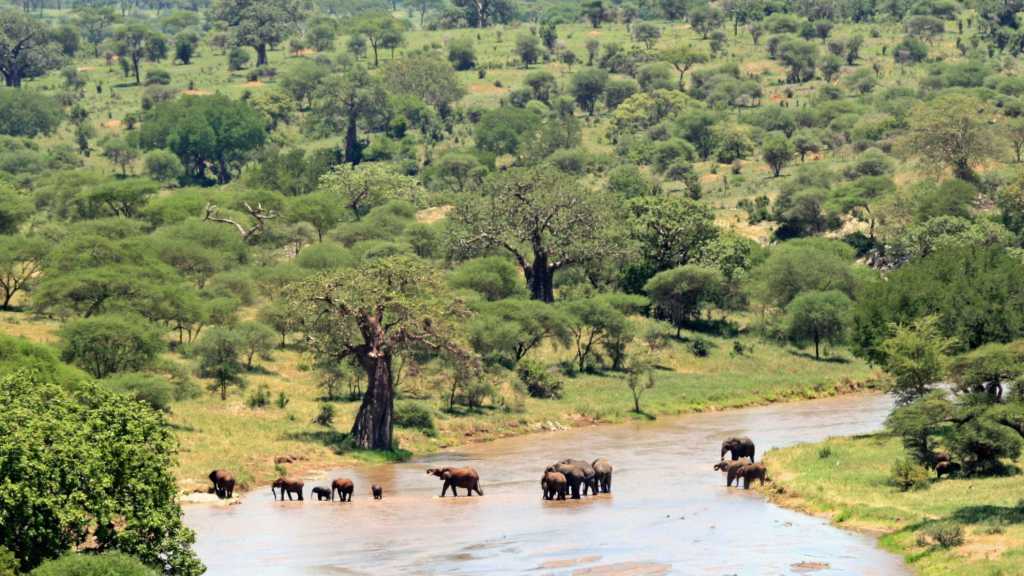Located south-east of Lake Manyara, the Tarangire National Park is crossed by the Tarangire River. Covering an area of 2,600 km², it has a sparse vegetation: riparian forests, acacia trees, sausage trees, and especially huge baobabs characteristic of this park. In addition, it has one of the largest concentrations of African elephants, feeding among others on the bark of acacias.
Observable throughout the year, the Tarangire National Park is also home to buffaloes, waterbucks, giraffes, zebras, a wide range of antelopes and warthogs, dwarf mongooses, many birds including red-and-yellow barbet, stocking-thighed ostrich and kori bustard (the heaviest flying bird), and a few predators: lions, cheetahs, leopards, hyenas.
Before the rains, streams of gazelles, wildebeest, zebras and giraffes migrate into the scrubby plains of the park, where the last pastures are still found.
- The discovery of the protected site of Ngorongoro requires 4x4 vehicle with sunroof only : minibuses are prohibited.
- The visit of the museum of the Olduvai Gorge in the protected area of Ngorongoro offers a nice cultural and historical break between 2 safaris...
- While it is technically possible to visit the parks with its own vehicle without going through an agency, the poor savings made do not compensate for the comfort and the light-heartedness of those who delegate logistics: entry into the parks, animal tracking knowledge, fuel containers...
- Each area of the Serengeti National Park deserves at least half a day safari, which means that a minimum of two to three days is required to visit the whole park.
- The Great Migration within the Serengeti moves all year round. Ask to know the best places according to the chosen period.
Tanzania, the African pearl
Ten million years ago the tectonic forces formed the great fault of the Rift. It was then that landscapes were sculpted over millennia and life began. Indisputable wild sanctuary, Tanzania can boast of possessing the greatest concentration of animals on earth. Conscious of this asset, it devotes 25% of its area to national parks and reserves. To this is added Zanzibar, an enchanting and bewitching island, bordered by miles of white sand and rocked by history.
When to go ?
Tanzania has a generally comfortable tropical climate year-round, although there are significant regional variations.
- Along the warmer and humid coast, the climate is determined in large part by the monsoon winds, which bring rains in two major periods.
- During the long rain season, from mid-March to May, it rains heavily almost every day, although seldom for the whole day, and the air can get unpleasantly sticky.
- During the short rain season during November, December and sometimes into January, the rain is lighter.
The best times to visit Zanzibar are from July to October and from December to March.
Formalities
- A passport valid for at least 6 months from the date of arrival in Tanzania is required by the Tanzanian authorities.
- The visa application must be submitted to the Tanzanian Embassy in the country of residence. However, when the traveller does not have the possibility to apply for a visa before departure, he can obtain it at certain border posts (to be paid in US Dollars):
- At the international airport of Dar es Salaam, Zanzibar and Kilimanjaro
- At the ports of Dar es Salaam, Zanzibar and Kigoma
Health
- No vaccination is mandatory but some vaccinations are recommended; Yellow fever vaccination is mandatory for all travellers from a country where endemic yellow fever is present but may be advised to all travellers. To avoid any inconvenience, it is strongly recommended to be up to date for yellow fever vaccination and to be in possession of an international vaccination booklet.
- Antimalarial treatment is recommended (see your doctor).
Currency
The monetary unit is the Tanzanian shilling (TSH) which is divided into 100 cents.
Credit cards are only accepted in certain hotels and restaurants in major cities. Travellers checks are very difficult to change. It is therefore strongly recommended to bring in foreign currency. Most payments can be made directly in US dollars from series after 2006. Banks and foreign exchange offices realize the exchange of your currencies. Never change money from intermediaries in the street, but only in exchange offices and banks.
Attention: Park fees as well as some lodges and hotel must be paid in US$.
